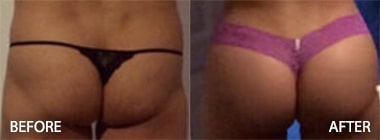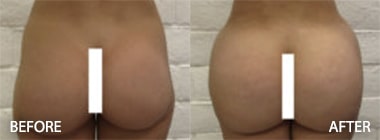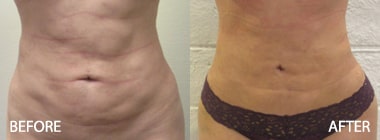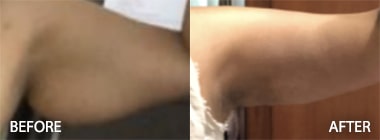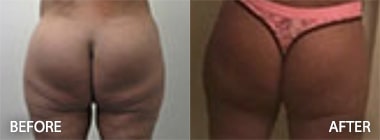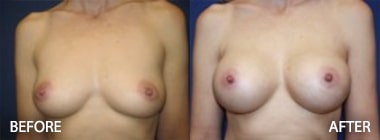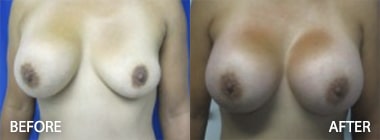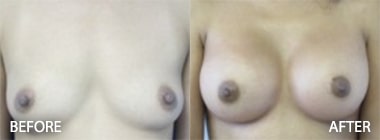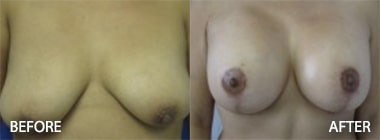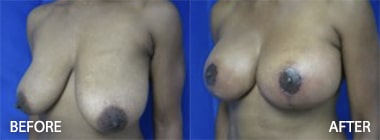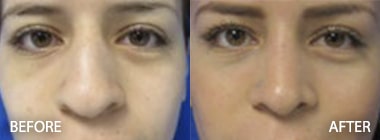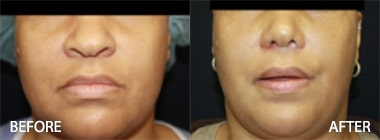Preoperative Evaluation in Aesthetic Head and Neck Surgery
Kenneth Hughes, MD
Anatomical Norms
A general recognition of facial norms and proportions has great relevance for the plastic surgeon during the preoperative assessment. The face can be divided into roughly equal thirds consisting of the trichion to nasal root, the nasal root to nasal base, and the nasal base to inferior mandibular midline (gnathion). All of these relationships are critical in face lifts, brow lifts, upper and lower eyelid surgery, rhinoplasty, and chin implantation.
The forehead comprises the area from the trichion to highest point of the brow. The average height is 7 cm in men and 6 cm in women. An aesthetic eyebrow has its apogee at the lateral limbus with the lateral extent positioned 3 mm superior to the medial. In women, the eyebrow rests up to 3 mm above the supraorbital rim. Conversely, in males, the eyebrow should lie at the level of the rim. The intercanthal distance should be roughly 34 mm in men and 32 mm in women. The youthful eye should exhibit a positive vector, with the lateral canthus 2 mm above the medial. Scleral show should not be present superiorly or inferiorly.
The nose is composed of three sections: root (radix), dorsum, and soft nose. The nose can be divided further into nine total subunits: nasal dorsum, tip, columella, paired ala, paired sidewalls, and paired soft triangles. The soft nose is comprised of the nasal tip, columella, and ala. The width of the ala should roughly equal the intercanthal distance. The angle between columella and upper lip (nasolabial angle) is 100 degrees in men and 105 in women.
The upper incisor show at rest should be about 2 mm. On lateral view of the face, the chin and upper lip should have similar projection.
It is important to realize that these proportions can vary subtly or rather dramatically based upon ethnicity. These norms have largely been developed based upon Caucasian models. Every effort should be made to preserve ethnic identity for any aesthetic facial surgerycontemplated.
Facial Exam
All facial assessments should include a thorough examination of the patient’s skin. The surgeon should note signs of poor skin elasticity, actinic damage, and deep facial wrinkles, as these factors can have dramatic implications upon any excisional or redraping procedure. Cranial nerve V and VII exams in particular should be performed and asymmetries noted. The relative amount of facial fat as well as overall facial shape (e.g. square or conical) should be documented. One should note the height of the trichion, the level of brow descent, and the amount of dermatochalasis. The surgeon should characterize the tear trough, the degree of malar fat pad descent, nasolabial fold prominence, degree of jowling, and relative laxity or banding of the platysma. A discussion of more specific anatomic considerations is better addressed in specific chapters, but one should bear in mind general facial characteristics as no one feature exists in a vacuum. Operating on one aspect of the face inevitably alters perception of the remaining facial elements.
Preoperative Planning
The history should include a complete medical and surgical history. The family history should include inquiries about familial bleeding tendencies and problems with anesthesia. A social history should include use of tobacco (nicotine products), alcohol, and illegal drugs. Allergies (including adhesives, skin prep, and latex) and medications (including BCP, OTC, vitamins, and herbal preparations) should be documented.
The surgeon should be able to accurately determine and predict anatomic characteristics that may result in difficult airways including poor cervical mobility, retrognathia, decreased cervicomental angle, and limited mandibular opening. Mallampati assessment of pharyngeal visualization is also a useful adjunct.
Patients with coronary artery disease, valvular disease, or congestive heart failure merit special consideration. A cardiologist should evaluate these patients to determine if their disease process is stable before one considers elective surgery for these patients. Patients with valvular disease should receive prophylaxis with amoxicillin or ampicillin. In pcn-allergic patients, clindamycin or a macrolide is appropriate.
The surgeon should obtain an accurate smoking history and determine if the patient has restrictive or obstructive lung disease as well as obstructive sleep apnea. Smoking should be discontinued for at least four weeks prior to elective surgery, and an aggressive smoking cessation program should be instituted. Serum and urine cotinine levels can be utilized to determine patient reliability.
Patients with chronic liver disease should receive liver function tests and may need a hepatology consult before considering elective surgery as they can carry greater risk for bleeding, malnutrition, and metabolic derangements. Chronic alcohol use can alter metabolism of perioperative drugs.
Hypertension, a contributor to hematoma formation, should be meticulously controlled. The patient should be well managed on an outpatient regimen, and any blood pressure medication should be taken the day of surgery. Anxiolysis and pain control should be addressed as well. Postoperative cough and vomiting should be controlled to prevent increased intraabdominal and intrathoracic pressures, which can lead to bleeding and hematoma formation. Propofol and a serotonin receptor antagonist such as Zofran should be considered unless contraindicated. Deep extubation in the hands of an experienced anesthesiologist can be utilized to minimize pressure increases during extubation. Nasal and throat packing should be used to minimize swallowed blood. Acid blocker prophylaxis should be considered in those with history of gastric esophageal reflux disease, hiatal hernia, and other diseases that may compromise gastrointestinal motility. Finally, patients should be free of ingestion of clear liquids for 2 to 3 hours and of solids for 6 to 8 hours prior to induction.
Diabetic patients should be well controlled to minimize wound healing implications. Glucocorticoid-dependent patients should be given Vitamin A, in doses of 25,000 IU/d, to help reverse many of the adverse steroid effects.
Surgical weight loss patients deserve special mention as nutritional deficiencies of vitamins A, C, and K may be present and impair normal wound healing. They may also have protein calorie malnutrition (serum albumin level of less than 3 g/dL may be indicative). Vitamin supplementation and protein supplements should be instituted prior to surgery to minimize wound healing issues.
To screen for bleeding diatheses, in addition to family history, a personal history of problematic bleeding with minor trauma (dental procedures), frequent nosebleeds, and history of blood transfusions suggest a clotting problem. CBC, PT, and PTT should be ordered, and a hematology consult may be appropriate. Aspirin and NSAIDS should be discontinued at least a week prior to surgery. Patients should stop taking Coumadin and Plavix at least five days prior to surgery and may require a temporizing measure (e.g. LMWH).
Though the risk for postoperative DVT and PE has not proven to be as high as for body contouring procedures, perioperative prophylaxis should be considered for longer operations and patients with multiple risk factors or previous DVT/PE. Young’s “The Need for Venous Thromboembolism (VTE) Prophylaxis in Plastic Surgery”1 provides a more detailed review and analysis.
High fever or prolonged ventilator requirements in patients or a family history thereof should raise suspicion for malignant hyperthermia and precautions should be taken if surgery is elected. With any perioral procedure, herpes prophylaxis should be considered based upon prior outbreaks. Isotretinoin use should be discontinued at least one year before considering any resurfacing procedure or operation.
Given the increasing popularity of the supplement market, the surgeon must have some familiarity with the more commonly ingested items. Echinacea may impair hepatic metabolism and should be discontinued well before surgery. Ephedra was used as an appetite suppressant that resulted in numerous deaths. The FDA prohibited the sale of ephedra in 2004. Garlic, ginkgo, ginseng, and kava inhibit platelet aggregation and should be discontinued at least 7 days prior to surgery. St. John’s wort should be discontinued at least 5 days prior to surgery and avoided postoperatively due to a host of drug-drug interactions. Valerian, a sedative, should be discontinued prior to surgery but should be tapered due to a benzodiazepine-like withdrawal.
Preoperative Laboratory Testing
Routine labs do not need to be performed unless elements of the history of physical suggest their appropriateness. Despite this, surgeons continue to order CBC, Chemistry, and PT/PTT routinely. A urine pregnancy test should be considered in all women of childbearing age. EKG may be ordered for the elderly or for those with a history of cardiopulmonary disease.
Patient Selection and Preoperative Counseling
Many of the technical pitfalls for a particular operation are presented in their respective chapters, but patient selection and preoperative counseling are perhaps the two most critical elements to having satisfied patients and avoiding poor outcomes. When evaluating the aesthetic patient, the surgeon should be able to recognize a patient’s motivations and expectations. Unrealistic expectations, obsession about appearance, incorrect perception of the surgery, or dismissal of criticism on the part of the patient should produce an uneasy feeling in the surgeon. These findings may merit a second meeting with patient, a psychiatric evaluation, or, perhaps, refusal to perform the procedure.
Click on the links below to view a few of the chapters written by Dr. Hughes
Chapter 2: Photography in Plastic Surgery
Chapter 3: Facelift
Chapter 4: Fat Grafting
Chapter 5: Fillers
Chapter 6: The Role of Dermal Matrices in Breast Augmentation
Chapter 7: Scar Revision in Plastic Surgery
Come to Hughes Plastic Surgery in Los Angeles and Beverly Hills. You will be glad that you did.
